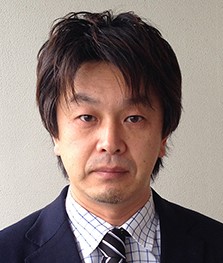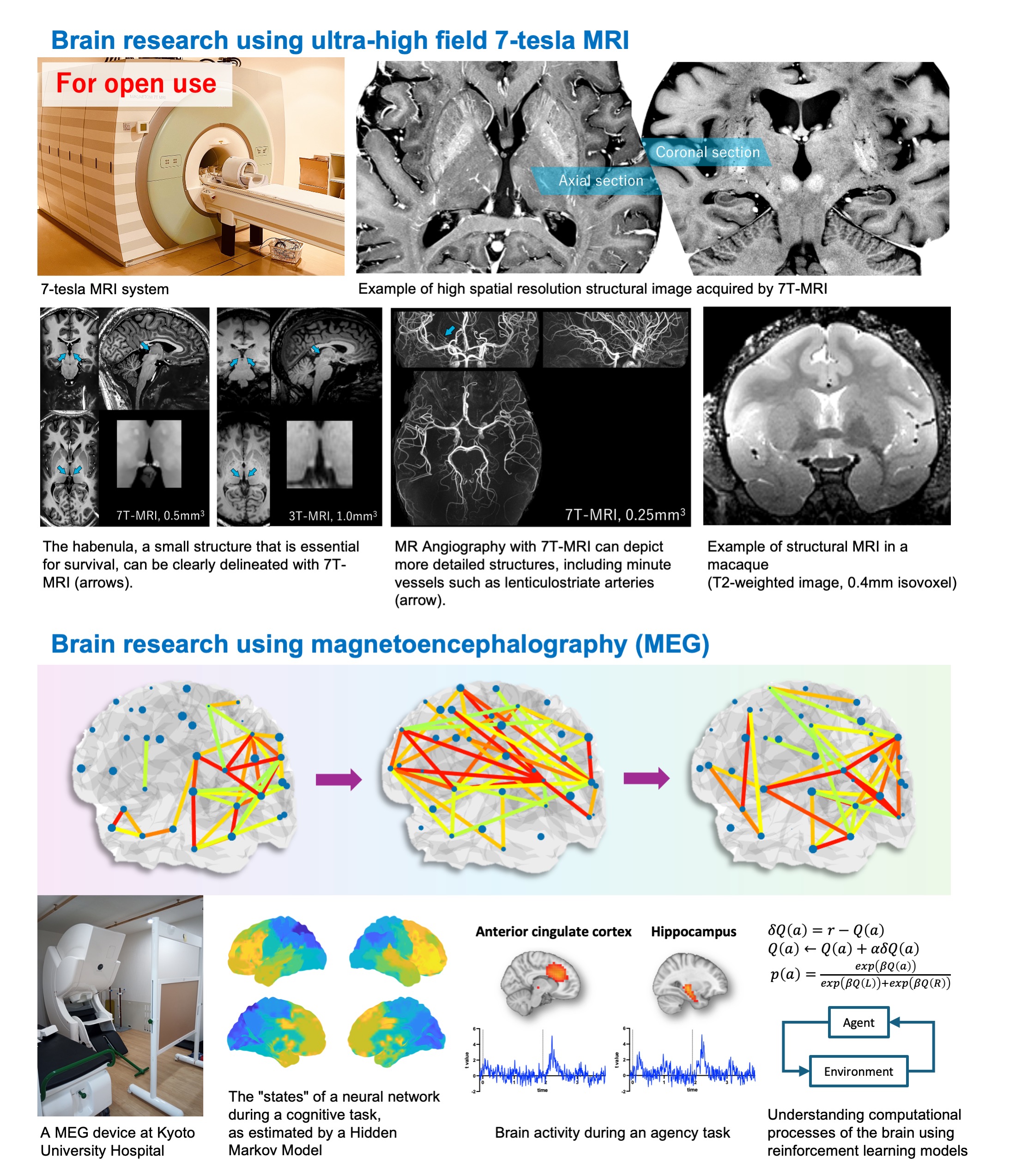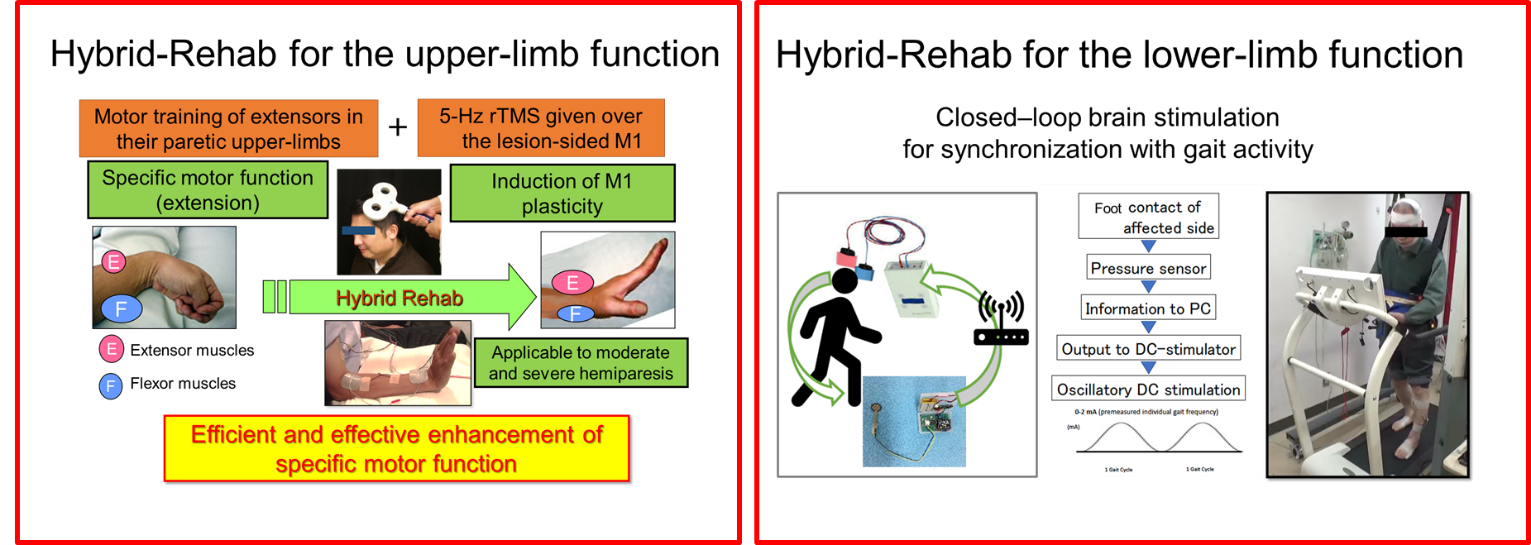
M.D., Ph.D. Director (concurrent service) Takashi Hanakawa
Human Brain Research Center (HBRC) conducts research on non-invasive brain imaging and stimulation to investigate brain structures, functions and its recovery by novel methodology. A human 7 Tesla MRI system, installed about 100 in the world and 6 in Japan, has been installed here in addition to a MEG system. We are developing new rehabilitative approaches to induce brain plasticity and improve dysfunctions more efficiently by combining brain stimulation and rehabilitative tasks. We are exploring human brain structures, functions and recovery of disabled function by cutting edge techniques.
Research and Education
The human brain comprises the largest and most developed system among animal species. Brain research should be done in a comprehensive and integrative way based on dynamic networking activities, not only in a reductionistic way based on hierarchy.
We focus on basic brain functions, pathophysiology and functional recovery in neurological and psychiatric disorders by using 7-T MRI, MEG and high-resolutional EEG for evaluation, and transcranial magnetic stimulation (TMS), direct current stimulation (tDCS) and static magnetic stimulation (tSMS) for treatment. Our aim is to contribute to clinical medicine and welfare of patients. We carry out education of the graduate school by collaborating with various medical departments related to neuropsychiatric diseases, regardless of whether it is in or out of the university. As a first and significant step, we participated in the establishment of the Center for Innovative Systems Neurotherapeutics (CiSNeuro) within Kyoto University Hospital.
 Brain imaging and Clinical Neurophysiology Field: We conduct non-invasive neuroimaging studies from basics to clinical applications, including usage of a 7T-MRI system and MEG.
Brain imaging and Clinical Neurophysiology Field: We conduct non-invasive neuroimaging studies from basics to clinical applications, including usage of a 7T-MRI system and MEG.
 Regenerative systems neuroscience: We conduct studies on recovery from brain dysfunction and disability by using hybrid rehabilitation techniques with non-invasive brain stimulation.
Regenerative systems neuroscience: We conduct studies on recovery from brain dysfunction and disability by using hybrid rehabilitation techniques with non-invasive brain stimulation.
Recent Publications
- Yoshinaga K, Matsushima T, Abe M, Takamura T, Togo H, Wakasugi N, Sawamoto N, Murai T, Mizuno T, Matsuoka T, Kanai K, Hoshino H, Sekiguchi A, Fuse N, Mugikura S, Tohoku Medical Megabank Brain Magnetic Resonance Imaging Study (TMMbMRI), Parkinson’s and Alzheimer’s disease Dimensional Neuroimaging Initiative (PADNI), Hanakawa T. Age-disproportionate atrophy in Alzheimer’s disease and Parkinson’s disease spectra. Alzheimer’s Dement (Amst) 17(1): e70048, 2025. doi:10.1002/dad2.70048
- Yamashita O, Yamashita A, Takahara Y, Okamoto Y, Okada G, Takamura M, Nakamura M, Itahashi T, Hanakawa T, Okada T, Togo H, Takagishi H, Hosomi, K, Kasai K, Okada N, Abe O, Imamizu H, Hayashi T, Koike S, Tanaka SC, Kawato M, Brain/MINDS Beyond Human Brain MRI Group. Computational mechanisms of neuroimaging biomarkers uncovered by multicenter resting-state fMRI connectivity variation profile. Molecular Psychiatry. 30:5463-5474, 2025. doi: 10.1038/s41380-025-03134-6
- Ishikawa Y, Oishi N, Kyuragi Y, Hatakoshi M, Hirano J, Noda T, Yoshihara Y, Ito Y, Miyata J, Nemoto K, Fujita Y, Igarashi H, Takahashi K, Murakami S, Kannno H, Izumi Y, Takamiya A, Matsumoto J, Kodaka F, Nakagome K, Mimura M, Murai T, Suwa T. Electroconvulsive therapy-specific volume changes in nuclei of the amygdala and their relationship to long-term anxiety improvement in depression. Molecular Psychiatry. 30:2653-2664, 2025. doi: 10.1038/s41380-024-02874-1
- Sasaki R, Ohta Y, Onoe H, Yamaguchi R, Miyamoto T, Tokuda T, Tamaki Y, Isa K, Takahashi J, Kobayashi K, Ohta J, Isa T. Balancing Risk-Return Decisions by Manipulating the Mesofrontal Circuits in Primates. Science 383(6678):55-61, 2024. doi: 10.1126/science.adj6645.
- Kyuragi Y, Oishi N, Hatakoshi M, Hirano J, Noda T, Yoshihara Y, Ito Y, Igarashi H, Miyata J, Takahashi K, Kamiya K, Matsumoto J, Okada T, Fushimi Y, Nakagome K, Mimura M, Murai T, Suwa T. Segmentation and volume estimation of habenula using deep-learning in patients with depression. Biological Psychiatry: Global Open Science. 4(4):100314, 2024. doi: 10.1016/j.bpsgos.2024.100314
Laboratory
Director: Takashi Hanakawa, M.D., Ph.D.
Associate Professor: Naoya Oishi, M.D., Ph.D.
Program Specific Associate Professor: Madoka Matsumoto, Ph.D.
Program Specific Associate Professor: Ryuta Aoki, Ph.D.
Program Specific Assistant Professor: Dinh Ha Duy Thuy, M.D., Ph.D.
Program-Specific Researcher: Kawakami Saki , Ph.D.
TEL:+81-75-751-3695
FAX:+81-75-751-3202
e-mail:hbrcoffice@kuhp.kyoto-u.ac.jp
URL:http://hbrc.kuhp.kyoto-u.ac.jp/
